#Bolt R-Spec
Explore tagged Tumblr posts
Text

From top:-
1966 Ford Fairlane 427 R-Code, a rare and powerful muscle car. Unique Features: Solid lifter camshafts, forged crankshaft, medium-riser aluminum intake manifold. Designed for drag racing and was known for its speed and performance. Only 57 (fifty seven) were made and all were originally Wimbledon White with a black interior. These spectral anomalies were built with minimal frills to maximize power. The R-code Fairlane was a street-legal drag racer. Mechanical details ⬇️
2nd from top:-
1967 Shelby GT500 Super Snake. It was originally a Shelby GT500 Mustang modified with a 427 cubic inch racing engine, and was intended to test Goodyear's Thunderbolt tires. It was capable of reaching speeds of around 170 mph.
427 cubic inch (7.0-liter) V8 engine derived from the Ford GT40 racing program. 550 hp (though some sources suggest over 600 hp) with 550 lb-ft. 0-60 mph: Approximately 4.1 seconds and top speed of 170 mph (274 kph). Kelsey-Hayes front disc brakes. Goodyear Thunderbolt tires.
3rd from top:- 1969 Ford Torino 428 Cobra Jet featuring a powerful 428 cu in (7.0 L) V8 engine rated at 370 hp, but some sources suggest it was also closer to 400 hp with optional Ram Air induction. Complete with competition suspension, oil cooler, staggered rear shocks, power front disc brakes, and heavy-duty springs. 0 - 60 mph in 7.7 seconds and quarter-mile in 15.8 seconds at 90 mph.
1968 Ford Torino GT 428 FE V8 Specs :- https://www.hotcars.com/highest-power-ford-torin-engine/#:~:text=Instead%2C%20Ford%20added%20a%20less,GT%20428%20FE%20V8%20Specs
4th from top:- 1969 Ford Mustang Boss 429. Officially rated at 375 hp, but likely closer to 475 hp or more and 450 lb-ft. of torque out of the 429 cu in (7.0 L) V8 with semi-hemispherical heads which Ford called "crescent". The Boss 429 was designed for NASCAR homologation and engine designed with Nascar Heavier Crank Shaft & Connecting Rods. The Mustang's body however was not wide enough to encompass the massive Boss 429 engine and as a result, Ford hired Kar Kraft out of Brighton, MI to modify existing 428 Cobra Jet and Super Cobra Jet Mach 1 Mustangs to properly fit the new Boss 429 engine.
It features a unique hood scoop, a chin spoiler, and optional rear spoiler and louvers. The interior included a top loader Hurst T-handle shifter. Only 859 units made in 1969 and auction prices have reached $1/2 a mil.
https://www.rmw.lv/car/en/mustang-boss-429-s-code-1969#:~:text=The%20cars%20were%20rated%20very,nothing%20has%20been%20actually%20proven.
5th and last:- 1970 Ford Torino Super Cobra with a 429 Super Cobra Jet engine. Difference from 1969 Ford Torino 428 Cobra Jet (3rd from top) engine lies in the engine itself and included features; 4-bolt main block & stronger block for better durability, forged pistons & stronger rods for enhanced performance & longevity, a larger, more aggressive mechanical camshaft for improved breathing & power, 780 CFM Carb: A larger 780 cfm Holley carburetor, header-style exhaust manifolds, an external oil cooler for better cooling & reliability & a Ram Air system for increased airflow and power & all these aided output in excess horsepower 425 (unofficially). To improve oomph, Super Cobra Jet often came with the optional Drag Pack, which included a stronger rear axle with higher gear ratios (like 3.91 or 4.30) and only 241 built with these specs.
youtube
#ford#ford racing#ford torino#ford mustang#ford cobra 🐍#police interceptor#cobra jet#ford fairlane#boss 429#nascar#racetrack#raceway#raceready#american exceptionalism#exquisitely#extremely#Youtube
9 notes
·
View notes
Text
Alright this is the most important thing I've ever asked you guys-
I feel like Ghost would be more of a Cruiser style kind of guy, but that's not to say I don't want him on a sports bike because oh my god-
Anyways, pictures under the cut & all bikes, regardless of color in the pictures, are going to be written in all black w. little skeleton accents!
Entries are also perfectly fine - if you have any ideas/headcanons, send 'em in! I also see Ghost in a more vintage model bike, but as of right now these models will do for a general style/baseline.
BMW F850 GS:
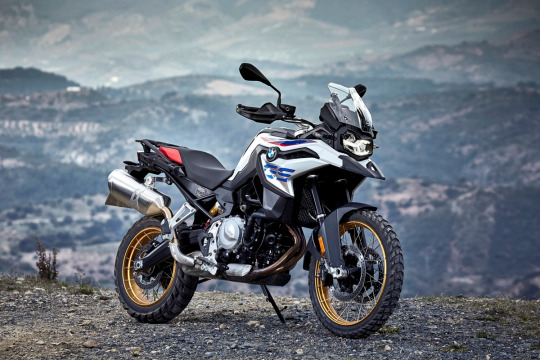
2023 CB1000R Black Edition:

2023 XSR700:
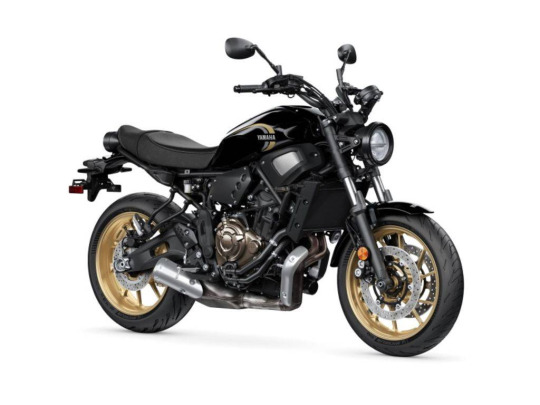
Honda rebel 500:

Yamaha Bolt R-Spec:

All pictures go to the respective owners
63 notes
·
View notes
Text
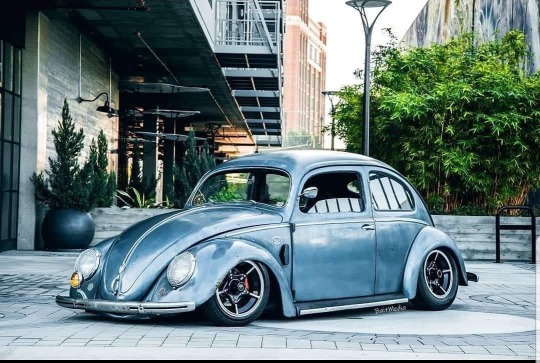
My Ultimate Plan | Airkewld | 1957 Beetle on a 1971 Chassis | Patrick
Client's Vision - 57 Beetle on a 71 IRS PAN What kind of wheels do you want to run?:15” Suspension Choice:Static - Set it and forget it Stopping Power: Disc Brakes - Self Adjusting Driving Style:Performance - More controlled, better handling, let's burn some rubber Ideal Engine: Performance - More Power, more torque, I want to have the ability to get out of my own way. Stance: classic rake lower in the front, almost stock height in rear, wide tires front and back on titanio Venus wheels, discs on all 4 corners, daily driver mostly, ideal engine is fuel injection, 1776-2017cc, freeway flyer transmission
Wheel Link - https://vwispwest.com/titanio-venus-15-x-5-5-wheel-r1128/
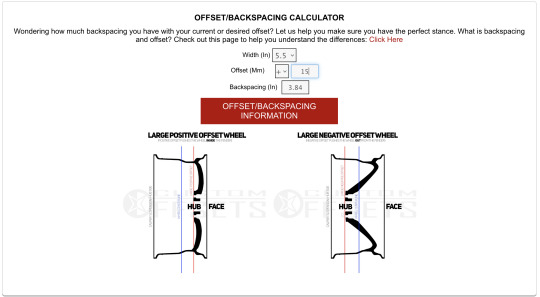
PRO's Plan for Patrick - If you go with he 15x5.5 wheel options they will come with a +15 or 3.84" backspacing up front, you would need a 5" Ultimate or PRObuilt Beam with shock towers for a performance build or a 6" shockless for a cruiser build. 165-60-15 tires up front. This is due to the Chassis swap you have and that makes the suspension platform 2" wider than your original 57 was. I think you would need to go with the same wheels in the rear but with an obviously taller wider tire. 205-65-15 tires in the rear.
As it would ship to the client for FREE in the lower 48 states, it would come with the following:
Stage 1 PRObuilt Beam complete assembled with sport shocks, drop spindles that is narrowed to spec to fit the wheels and the stance the client is looking for and GEN 2 BAD Series Brakes are installed in a Wide 5x205mm bolt pattern and outfitted with 4 piston grey Wilwood calipers. This will give him the stopping power he wants, the stance he is after and ability to give him the best user experience possible. In the rear, we went with an eBrake style NON Wilwood caliper and the Wide 5 GEN 2 IRS BAD Series Brakes couple with adjusting the torsion's to fine tune his ride height and installing a set of rear shocks and Stainless Steel hardware.


$6500 Delivered to an R&L Terminal closest to our client. All forms of payment are available and it can even be financed during checkout.
If you want to add all of these items to a cart and check them out yourself, you can here - https://airkewld.co/57-71UltimatePlan
Classic Volkswagen Drive-Train built by PRO’s that care about quality, fit-n-finish, for the Best Clients in the World 🌎
✉️ [email protected] 📞 or 💬 1-623-518-3537 🗣️ DM for more ☝️ on ☝️
25 notes
·
View notes
Text
The Role of Conical Strainers in Protecting Pumps and Valves
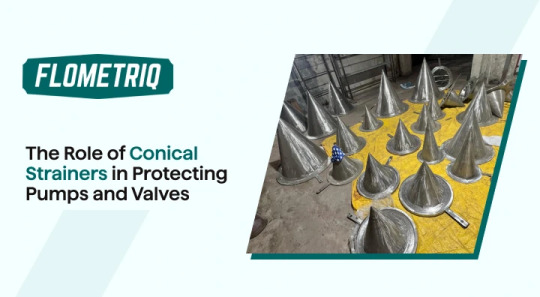
Protecting pumps and valves from debris during system startup ensures reliable operation and avoids costly downtime. New or modified pipelines often carry leftover construction materials—like rust, welding slag, and scale—that can seriously damage sensitive components. This is where conical strainers play a critical role.
What Are Conical Strainers and Why Are They Important?
Conical strainers (temporary cone strainers )are cone-shaped mesh or perforated metal filters placed between pipe flanges. They're designed for short-term use during pipeline systems' commissioning or startup phase.
When fluid flows through a newly installed system, it can carry construction debris that may damage pumps, control valves, and meters. Conical strainers capture this debris early on, offering essential protection when the system is most vulnerable.
Why Startup Debris Is Dangerous
New pipeline systems often contain:
Welding slag
Rust particles
Pipe scale
Jointing compound
These materials can lead to:
Abrasion and erosion of the pump and valve components
Clogging of narrow passages and filter elements
Seizing of moving parts due to large debris
Reduced performance and internal leakage
How Conical Strainers Work
The effectiveness of conical strainers lies in their design. Inserted between two pipe flanges, their cone shape offers a large surface area for filtering. As the fluid passes through, solid contaminants get trapped inside or outside the cone—depending on the orientation.
This setup ensures:
High filtration efficiency
Low pressure drop
Easy debris collection and removal
Benefits of Using Conical Strainers
Using a conical strainer during startup provides several advantages:
Protects expensive components from early failure
Extends equipment lifespan by preventing wear
Reduces maintenance costs and emergency interventions
Prevents unplanned downtime
Improves overall system reliability
Material Options:
Stainless Steel 304 / 316 (corrosion resistance)
Carbon Steel
Monel and other specialty alloys
Key Specs to Consider:
Mesh/perforation size (determines what particles are captured)
Open area ratio (impacts flow capacity)
Installation Best Practices
To maximize performance:
Orientation: Install the cone upstream or downstream based on system needs.
Sizing: Match pipe diameter, flange rating, and bolt circle.
Sealing: Use appropriate gaskets to ensure leak-free operation.
Temporary Use and Maintenance
Most conical strainers are designed for short-term use. Once the system has been flushed and debris removed, the strainer should be taken out to prevent pressure drop and clogging.
To remove:
Isolate the section
Depressurise the line
Unbolt the flanges
Remove the strainer carefully.
Conical vs. Permanent Strainers
Use Conical Strainers for temporary protection during startup.
Use Permanent Strainers (like basket or Y-type strainers) for ongoing filtration needs.
Industries That Use Conical Strainers
Conical strainers are widely used in industries where clean fluid flow is essential from the start:
Oil & Gas
Chemical Processing
Power Generation
Marine
Water Treatment
Food & Beverage / Pharmaceutical
Pulp & Paper
Final Thoughts: Start Clean, Stay Efficient
A smooth startup sets the foundation for reliable operations. Conical strainers are a cost-effective, temporary filtration solution that protects your pumps, valves, and instrumentation from damaging debris. They help avoid unexpected downtime and reduce long-term maintenance costs.
If you're commissioning a new system, don’t overlook this small but powerful piece of equipment. It’s been the smart way to protect your bigger investments from day one.
For more information, please visit.
#conical suppliers#conical strainers suppliers#conical strainers manufacturers#duplex strainers manufacturers
0 notes
Text
Explore BMW R nineT 1170 – Specs, Features & Performance
When it comes to blending heritage with innovation, few motorcycles do it better than the BMW R nineT 1170. Designed for purists who appreciate the essence of motorcycling with a touch of modern engineering, this bike is a compelling mix of performance, timeless aesthetics, and German precision. Let’s dive deep and explore the BMW R nineT 1170 – its specs, features, and performance – and understand what makes it such a beloved machine in the world of motorcycles.
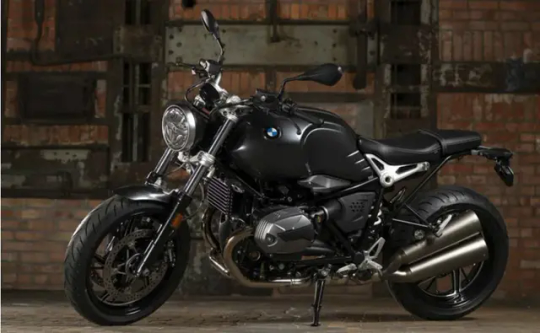
The Legacy of the BMW R nineT
Since its debut in 2014, the BMW R nineT has captivated riders with its vintage-inspired design and spirited performance. The 1170cc air/oil-cooled boxer engine pays homage to BMW Motorrad’s rich history while offering the reliability and muscle demanded by today’s riders.
In this article, we will explore the BMW R nineT 1170 in detail—discussing what makes it a standout in the modern retro segment, covering everything from specs and features to real-world performance.
Engine & Performance
Powertrain Specifications
At the heart of the BMW R nineT 1170 is its iconic 1170cc air/oil-cooled two-cylinder boxer engine. This engine is a staple of BMW’s motorcycle lineup and offers a powerful yet smooth riding experience. The engine produces a solid 109 horsepower at 7,250 rpm and 116 Nm of torque at 6,000 rpm.
The boxer engine’s unique layout contributes to the bike’s low center of gravity, improving handling and offering exceptional road stability. The bike features a six-speed transmission and shaft drive, reducing maintenance compared to chain-driven motorcycles.
Acceleration and Handling
When you explore the BMW R nineT 1170 on the open road, you’ll notice its impressive throttle response and linear power delivery. It accelerates confidently from low revs, making it perfect for both city rides and long highway stretches.
The combination of a responsive clutch and smooth gear shifts contributes to an engaging riding experience. In corners, the bike feels planted, thanks in part to its balanced chassis and adjustable suspension.
Design & Build Quality
Retro Style Meets Modern Craftsmanship
The R nineT 1170 stands out with its distinctive classic styling. The round headlamp, sculpted fuel tank, and exposed rear subframe give it a rugged, minimalist appearance reminiscent of vintage café racers. However, the build quality is unmistakably modern, with premium materials and impeccable fit and finish.
BMW offers several customization options, allowing riders to tailor the R nineT to their individual taste. Whether it’s a scrambler-style seat, wire-spoke wheels, or bespoke paintwork, the R nineT supports personalization like few others.
Frame and Ergonomics
The bike features a modular steel tubular frame with a bolt-on rear subframe. This not only enhances the bike's aesthetics but also allows riders to modify it with ease. Ergonomically, the upright seating position offers comfort for longer rides, and the controls are intuitive and well-placed.
Suspension, Brakes & Wheels
Ride Comfort and Stability
The BMW R nineT 1170 comes equipped with high-quality suspension components. The front suspension uses an upside-down telescopic fork, while the rear is supported by a Paralever single-sided swingarm with a central spring strut. Both ends are adjustable, offering a smooth and stable ride across varied terrains.
Braking System
Stopping power is delivered through dual 320mm front discs with four-piston radial calipers and a single 265mm rear disc. BMW's ABS is standard, ensuring safe and controlled braking under all conditions.
Wheels and Tires
The standard model comes with 17-inch cast alloy wheels, although spoked wheels are available for those seeking a more vintage appearance. The tires offer excellent grip and ride quality, making it a confident performer on twisty roads.
Technology and Features
Modern Rider Aids
While the R nineT 1170 leans heavily into retro styling, it doesn’t skimp on tech. Standard features include ABS, adjustable suspension, and ride-by-wire throttle. Optional packages can add heated grips, traction control (ASC), and cruise control for enhanced touring comfort.
Instrumentation
The analog-style twin dials—speedometer and tachometer—are complemented by a digital display providing additional information like gear position, trip meters, and fuel range. This fusion of analog and digital interfaces contributes to the bike’s retro-modern appeal.
Real-World Usability
Everyday Versatility
When you explore the BMW R nineT 1170 in everyday conditions, its versatility becomes evident. It’s agile enough for daily commuting and comfortable enough for weekend road trips. The 18-liter fuel tank offers a decent range, and the seating is supportive over longer durations.
Maintenance and Reliability
The shaft drive, robust engine construction, and BMW’s engineering pedigree ensure long-term durability. Regular service intervals and widely available parts add to the practicality of owning this bike.
Who Should Ride the BMW R nineT 1170?
The R nineT is best suited for riders who appreciate the aesthetics of classic motorcycles but don’t want to compromise on modern performance and safety. Whether you're a seasoned enthusiast or a rider returning to motorcycling, the R nineT offers a rewarding experience.
If you're looking to explore the BMW R nineT 1170, it’s important to recognize it’s not just about numbers—it’s about feel. The raw, mechanical nature of the boxer engine combined with premium craftsmanship creates a connection between man and machine that’s rare in today's market.
Customization & Community
BMW’s R nineT platform is known for its modular design and rich aftermarket support. Riders can easily modify the seat, exhaust, fenders, and more. This has led to a thriving community of custom R nineT builders who showcase unique interpretations of the platform—from scramblers and bobbers to full-on café racers.
When you explore the BMW R nineT 1170 through the lens of customization, its true potential is unlocked, allowing riders to create something that reflects their own identity.
Conclusion
To explore the BMW R nineT 1170 is to journey through a harmonious blend of tradition and innovation. With its air-cooled boxer engine, premium build quality, and endless customization potential, it offers a riding experience that’s emotional, engaging, and deeply satisfying.
Whether you're a fan of classic design or simply seeking a reliable and stylish performance bike, the R nineT delivers on all fronts. For anyone who values craftsmanship, power, and personality in a motorcycle, this machine is not just a purchase—it’s a passion project.
#BMWRninet#BMWRninet1170#BMWMotorcycle#CafeRacer#RetroBike#ModernClassic#BoxerEngine#CustomMotorcycle
0 notes
Photo

New Post has been published on https://www.vividracing.com/blog/what-wheels-fit-a-nissan-gt-r-r35/
What Wheels fit a Nissan GT-R R35?
Finding the right wheel fitment for the Nissan GT-R R35 takes some effort, but we’ve done the research so you don’t have to. The R35 came to the USA market in 2009 and the last Nissan GT-R R35 is scheduled to be built in 2025. Where power and some aesthetics have changed, the majority of the vehicle has been left the same. With a 20 inch OEM wheel size, the only difference ever in the wheels was from the Nismo edition using a 14×1.5 wheel bolt.
So what are the important numbers to look at when it comes to wheel sizing? First you have the diameter. This is the wheels main size as you look at its face. Diameter takes us back to Junior High and looking at the centerline of a circle. But it’s important to understand how different diameters can affect performance. Larger diameter wheels require more effort to spin. So this could reduce performance. Taking this into consideration, putting 22 inch wheels on a Nissan GT-R may not be a great idea. One of the big considerations when evaluating what wheel size to go with is tire availability. Depending on your vehicle use, some sizes may not be available in certain compounds such as track tires. Trying to find an R Compound tire for the track in a 21 inch is not going to be easy. Where sizes such as 18 inch you can find several different tire brands available. Smaller diameter wheels have to be able to clear the Nissan GT-R massive brakes. So understanding the offset and width is key to the right wheel size.
Wheel width is exactly how it sounds. How wide the wheel is when it is touching the ground. The Nissan GT-R uses a pretty wide wheel stock. The stock wheel is a 20×9.5 +45 and 20×10.5 +25. There is a lot of room in the fenders to go with a wider wheel to get better traction. The wheel offset is what can determine how wide of a wheel you can go to properly clear the brake caliper, stay in the fender well, and not hit the coilovers. Offset is measured as backspacing from the wheel pad where it mates up to the brake rotor hat. The lower the number the offset is, the further it is pushed out towards the fender. The higher the number it is more tucked in. So if you compare a wheel offset of 25, to a wheel offset of 50, the 25 offset will sit with the outside edge closer to the fender lip.
Some additional numbers to take into consideration for your wheel specs are bolt pattern, centerbore, weight, and load rating. Bolt pattern is very specific to each vehicle. If a vehicle runs a 5×114.3 bolt pattern, you cannot put a 5×120 wheel on it. There are spacer conversions available on sites like Amazon, but for a car like a Nissan GT-R, you would not want to do this. As mentioned above, the wheel bolts that the wheel mounts on to is different between the standard and Nismo versions. Centerbore is the hole that fits over the brake rotor lip in-between the bolt pattern. This is what keeps your wheel hubcentric and balanced. Many companies sell hubcentric rings for wheels that are more universally bored out. This is not wrong or bad. It’s a way to have a wheel available for many different applications. Wheel load rating is important for the safety of you and your vehicle. If the wheel construction is not rated for your vehicles weight, you could have catastrophic failures in the wheel. For example you would never want to put a Toyota Prius wheel on a Tesla Model S. The weight difference would put that wheel under extreme stress which may lead to cracking. But in our eyes, the most important number after all the others is wheel weight.
Wheel weight is hugely important to the performance of your vehicle. Rotational weight has a factor of 3x compared to static weight. If you save 10lbs on upgrading your wheel per corner, that is like saving 30lbs per corner. The less the engine has to work to get your car rolling, the faster it will go. So when looking at different wheels, it’s important to compare them to the stock wheel weight to see how they will perform.
After evaluating a variety of great wheel setups for the Nissan GT-R, we’ve pinpointed the best options that balance performance, practicality, and style for you. Whether you’re preparing for the track or just aiming for a clean street look, these fitments will ensure your Nissan GT-R performs as well as it looks.
Recommended Fitment:
Front 20×10 +30mm 5×114.3
Rear- 20×12 +25mm 5×114.3
Aggressive Track Fitment:
Front 18×10 +15mm 5×114.3
Rear 18×12 +25mm 5×114.3
src=”https://www.youtube.com/embed/hi7CeFx1w6Q” title=”YouTube video player” frameborder=”0″ allow=”accelerometer; autoplay; clipboard-write; encrypted-media; gyroscope; picture-in-picture; web-share” allowfullscreen>
Our Top Wheel Choices
Volk Racing – This iconic JDM wheel company is a top pick for many GT-R owners. Their 1pc forged aluminum wheels come in the right sizes and look to properly equip your Nissan GTR. The most common wheel is the TE37 and the variants of that style from Volk Racing.
Advan is another Japanese brand by Yokohama. Their wheels are also a staple on many GT-R owners cars. These wheels are typically a flow forge or cast construction. Some of their wheels are fully forged as well. Popular models such as the Advan GT and Advan RZ can be found on different GT-R owners cars.
Work Wheels – This is another Japanese wheel manufacture that is synomonyous with racing heritage. Their wheels are available as 1pc or multi-piece construction. Work Meister wheels are pretty common for popular JDM cars such as the Nissan GT-R.
BBS Wheels – This is the most common name in motorsports and racing. BBS has a long standing heritage in high performance vehicles. Their Forged Line of wheels brings a good balance of style and performance to the Nissan GT-R community.
There are several USA wheel manufactures that built great custom wheels for the Nissan GT-R. This includes companies like HRE Wheels, Brixton Forged, Rotiform. Getting a custom wheel in a 1pc forged monoblock or 3pc forged in your own color and style is a true way to separate your Nissan GT-R from the others.
Of course we have our very own VR Forged wheel line up. Available in ready to ship instock 1pc forged wheels or custom designed, our own wheel line has taken queues from our 20+ years of experience to provide a lightweight functional wheel for Nissan GT-R owners.
View Different Wheels on the Nissan GT-R
Screenshot
0 notes
Text
I blame Rodimus for this...
Hello. I am Gravity Waltz.
I am a Lutarist and Songstress (singer).
I was assigned to the Lost Light as a source of "company morale".
From what I HAVE heard of the humans' music, I actually enjoy the ones from 2014 and 2015.
---
Made ANOTHER one of these. This is for my TF RP OC Gravity Waltz who comes from the MTMTE continuity.
Her Lutar is basically the guitar that Adam from Hazbin Hotel has.
This is her alt-mode but in grape purple with a cyan gradient for anyone who wants to draw her:
This is ooc
This is Gravity Waltz speaking normally
This is Gravity Waltz speaking a little louder
This is Gravity Waltz shouting
RP Rules:
If you EVER feel uncomfortable during these RPs please let me know!! I don't want to accidentally make anyone feel discomfort.
Self-Inserts and OCs are totally fine as long as you give me like a rundown of who they are.
I may do NSFW, but only in DMs (NO MINORS!).
You are allowed to draw fanart of Alarinthia for any ongoing RP stories, be sure to tag me when you do because I REALLY want to see it.
More about Gravity Waltz:
She is currently single and ready to mingle.
She did have a previous partner but broke up with them after they cheated on her.
She is half Insecticon, meaning she does have a second alt-mode that is a Sylvana Jumping Spider.
Her Sire was a Cybertronian while her carrier was an Insecticon.
While never having fought in the war nor joining the Decepticons, she hated the old caste system as well and supported them from the shadows.
She is a straight ally.
She uses the spider silk she generates as a way to stim.
The scar on her face was from when she tried to defend an abandoned Sparkling.
My main blog is @sassycandypoetry
0 notes
Text
It Really Is That Good

Some carmakers have flagships that they always throw their whole weight behind. The Porsche 911, Chevy Corvette, and Mercedes S-Class come to mind. Honda has that too, but instead of a single model, it has a moniker: Type R. It may mostly compete on the budget end of car market, but Honda is an engineering powerhouse with massive, two- and four-wheel motorsport-dominating, HondaJet-releasing pride. It could make a supercar, and it has. Twice. They were both fantastic, even if we only understood just how good they were with time. But Honda doesn’t limit itself to showing that flair in supercars alone. Type R is Honda’s gateway into throwing that weight toward the more pedestrian end of the market. A Type R is a reason to sit up and pay attention because, more often than not, it’s Honda bringing its A-game to a humble sport compact. And it all started with the DC2, the 1996 Honda Integra Type R.

JDM 1996 Honda Integra Type R. James Gilboy The original Integra Type R’s renown is so great that it’s often held in the same regard as Japan’s more powerful forbidden fruit, like the Nissan Skyline GT-R. But reverence is a double-edged sword, and unrealistic expectations can turn even a terrific car into a letdown. The Integra Type R’s fame could be its own worst enemy, and besides: the Integra has always been just a fancy Civic. How good could the original Type R really be? All doubt evaporates the instant you shift from first at the towering 8,400-rpm redline, and drop into second right on the 6,000-rpm threshold of VTEC. Everything about the Integra Type R is designed this holistically; every change Honda made amplifies all the others in a way that makes the Type R far exceed the sum of its parts. It’s a driving experience with no modern analog and one that somehow ranks among the very best cars I have ever driven. It’s proof that you can have rear-wheel drive, all the power in the world, and enough tech to confuse Star Trek’s Borg and still fall short if you can’t tie together the fundamentals. The Honda Integra Type R does this perfectly, and it sets a high bar that even many of the best performance cars today still fall far short of. 1996 Honda Integra Type R Specs Powertrain 1.8-liter naturally aspirated inline-four | five-speed manual transaxle with a helical limited-slip differential | front-wheel drive Horsepower 197 @ 8,000 rpm Torque 131 lb-ft @ 7,500 rpm Curb Weight 2,480 pounds Seats 4 Quick Take The original front-wheel-drive Type R makes driving thrilling like almost no car made before it—or since.




JDM 1996 Honda Integra Type R. James Gilboy Introduced in 1995 in Japan, the Honda Integra Type R built on what was already an excellent compact car chassis, with double-wishbone front suspension, semi-trailing arm rear, and a responsive 1.8-liter four-cylinder. Technically, it’s just an upmarket Civic, but that’s no diss: this is a serious platform that can go head-to-head with sports cars of its era on a track. I know this from experience; I’ve raced a class-winning Integra, and even that was more car than most people can drive to its limits on track. The Type R, meanwhile, is on a whole ‘nother level—maybe two. While some performance models amount to factory bolt-ons and an ECU tune, the Type R is different down to the chassis. Honda gave Type Rs extra seam welds and chassis bracing to improve rigidity while shedding weight with alloy wheels, a thinner windshield, less insulation, and deleting equipment like air conditioning and the sound system. To capitalize on cutting 93 pounds, Honda retuned its suspension and fitted bigger brakes to compensate for its hand-built 1.8-liter B18C four-cylinder.


JDM 1996 Honda Integra Type R. James Gilboy Honda hand-polished its head ports, increased its compression ratio, and fine-tuned its intake and exhaust to make what was then the most power-dense naturally aspirated engine ever in a road car. The result is a broad torque curve and an 8,400-rpm redline, where the second cam profile doesn’t come on until around 6,000. Its 197 horsepower and 131 lb-ft don’t sound like much, but they were enough to justify including a helical limited-slip differential in its five-speed manual transaxle. It too has been tailored specifically for the Type R, with close ratios to keep you in the power band, and a short final drive. Now, the Integra Type R for all its renown wasn’t a Japan exclusive. Left-hand-drive models were sold in the United States with a different front end, leather seats, and marginally less power. (We also got the lesser GS-R, which is still coveted today.) But the vast majority of DC2s were sold in Japan, where this right-hand-drive example came from. One of the most common tells that you’re looking at a Type R clone is a four-lug hub. The car I drove has them, but they were standard on all early DC2s; five-lug hubs didn’t arrive ‘til 1998. You’d be hard-pressed to fake the Type R’s body-hugging Recaro bucket seats, exclusive shift knob, small-diameter steering wheel, and spritz of carbon fiber trim. That also goes for the Type R-embroidered floor mats, decals, and DC2 serial plate under the hood. Besides, you’d be able to tell the real thing just from how Type Rs drive.










JDM 1996 Honda Integra Type R. James Gilboy From the second you sink into the seat over its tall bolstering and roll out onto the road, everything about the Type R feels tight. Everything from the way the Recaros cup you to the small steering wheel, which hastens the steering rack and adds weight to its feedback. The clutch bites like a gator, and the chassis feels stiffer than a regular Integra, though not in the harsh way modified cars often do. It’s more refined than that, though not on the front of sound deadening: there’s a good deal of road noise. Honda’s manual transmissions with their short, slick throws are always a joy to operate, and you operate the Type R’s a lot because man, these gears are short and close. The Type R is already spinning more than 2,500 rpm in fifth by 45 mph, and it exceeds 3,000 by 55. A highway cruiser—no, a daily of any kind—this isn’t, and not just because of gearing or noise. Its back seat is too small for adults and hard to access through its coupe doors, while no cupholders are to be found. Its low chin scraped too, on what I wouldn’t even consider much of a dip. You’d have to be out of your mind to use the Integra Type R as a commuter—unless your route follows first-rate back roads, which is where the Type R shows what it’s really made of.




JDM 1996 Honda Integra Type R. James Gilboy Scoff at 1.8 liters and 131 lb-ft all you want, but stiff engine mounts and short gearing amplify what torque there is for a lively response at low to mid revs. Mid of course goes a lot further than in most cars, to about 6,000 rpm, which is where (pardon the cliché) VTEC kicks in, yo. You know the drill: you’re already turning enough rpm that many cars are ready to grab the next gear when the engine note changes character entirely, and the revs rise even quicker than before. Aaaaall the way up to 8,400 rpm, each rotation vibrating your entire body through the stiffened chassis and bucket seat before you slip the shifter into second—resetting the tach to 6,000, where the adrenaline jolt begins again. So it goes from second to third, and I would imagine fourth and fifth. A multi-gear pull in a DC2 is what I imagine railing multiple consecutive lines of cocaine to be like; I can’t count how many times this engine made me say, “Holy shit!”


JDM 1996 Honda Integra Type R. James Gilboy It wasn’t just the engine that made me swear, either. That extra chassis rigidity shows up most conspicuously in the rear of the Type R, which doesn’t roll like a regular Integra. It’s stable, trustworthy, even ignorable, freeing you to focus on the business end of the Type R: the front axle. The steering is neither burdensome nor too light, and its response and feedback accentuate the sense of speed the Type R carries through each corner—no matter how tamely or wild you drive. Front-end traction was so great that I never got to put its LSD to the test, and the brakes did their silent, honorable job without getting too long in the pedal like many Hondas can. Every last detail of the Type R is designed to keep your attention on the front end: the steering, the engine, the transmission, and you; the maestro of this Super Eurobeat album on wheels. It banishes fear of over- or understeering and makes you ask yourself, “How fast can I take that?” of each corner. The Integra Type R heightens your sense of speed in a way that you don’t need a deathwish and a disregard for the redline to deeply enjoy it. Even if you don’t venture into the upper reaches of the tach more than once a week, the audible and tactile feedback still make it one of the most exciting cars I’ve ever driven. It’s still deceptively quick, though: Best Motoring found its track pace wasn’t far off the fastest Japanese cars of the era. I’d wager it’s a more exciting drive than an R33 Skyline GT-R or Mk4 Supra, too.



JDM 1996 Honda Integra Type R. James Gilboy
What To Know Before Owning
Many cars of the 1990s are getting tough to find parts for, but Hondas have so much interchangeability that you’ll be able to fix ‘em as long as we have gas to fuel ‘em. Mods are technically an option, but nothing about the driving experience needs fixing, and it’d be worth more kept stock anyway. What’s more likely to be an ownership issue is condition—not so much mileage, but age, and the fact that you’re buying a used Type R. Odds are, every owner has driven their car as hard as you hope to. But again, ’90s Hondas will be fixable for our lifetimes, and what’s more likely to claim your Type R is theft. Hondas of this era are infamously easy to steal, on par with Kias and Hyundais as of late, so it’d be worth investing in an ignition interlock, GPS tracker, steering wheel club, and bolt cutter-resistant locks for your trailer. Between its unsuitability as a daily, risk of theft, and value, a Honda Integra Type R is best owned by someone with a garage who takes it out for great local roads or the occasional track day. It may be a FWD Honda with less than 200 hp, but it’s absolutely worthy of the best tarmac on the planet.



JDM 1996 Honda Integra Type R. James Gilboy
Verdict
The Honda Integra Type R truly deserves the reverence it’s held in by Honda fanboys and weeaboos; I never wanted my drive to end. Even decades later, measured against the many greats that have followed it, the Integra Type R more than holds up. If anything, the way modern cars dull your sense of speed rather than accentuate it only highlights how close to the apex of the automotive experience Honda got—all with a front-drive compact wearing stickers and a goofy wing. Read More Top Five Most Common Questions About Car Fuel Averages The Future of Classic Cars: Electric Conversions and Modern Upgrades How SpaceX Plans to Land Starship on Mars Read the full article
0 notes
Text
14-20 YAMAHA BOLT REAR PILLION BACK SEAT + FOOT PEGS PEDAL FOR YAMAHA BOLT XVS950R MOTORCYCLE
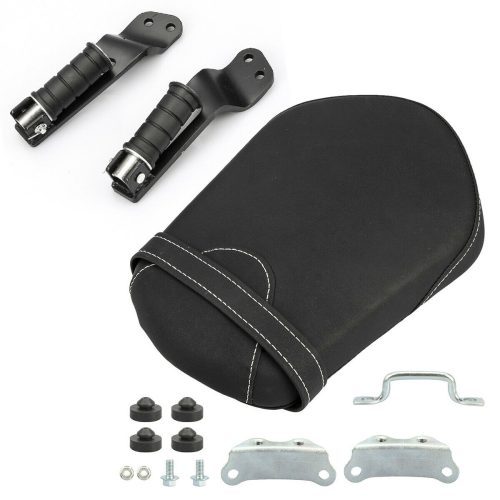
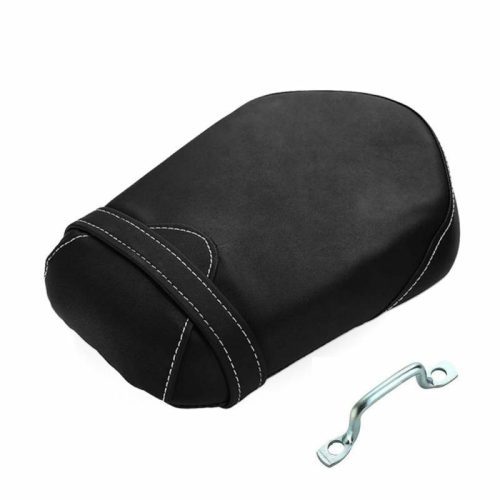
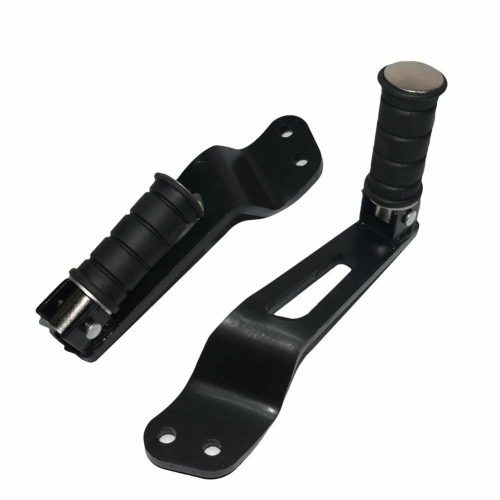
Aftermarket 14-20 Yamaha Bolt Rear Pillion Back Seat + Foot Pegs Pedal for Yamaha Bolt XVS950R Motorcycle by SMA
Description
Yamaha Bolt R-Spec Passenger Seat Kit w/ Cream Stitching
Fits
2014 – 2017 Bolt R-Spec
The Passenger Seat Kit is a convenient kit which allows you to quickly convert your Bolt to a two-up ride to accommodate a passenger.
Designed to match OEM components for a fully integrated, genuine OE look.
This kit is only for the R Spec model Bolt.
Included in the kit:
Passenger seat,
Passenger foot pegs,& all necessary mounting hardware.
This kit is necessary equipment if you are planning on adding a passenger backrest or rear rack.
Footrest:
Material:Heavy Metal+Rubber
Quality:1Pair(Left&Right)
Slim footpeg design allows a comfortable pivot point
Wide surface and large diameter end cap keep your boot in place.
Passenger seat:
Material:Synthetic Leather
Color: Black
Size: Approx
Length:13.00″
Width: 8″
Thickness: 2.00″
Package Details:
1x Passenger Seat + 1x Passenger Foot Pegs
0 notes
Photo

New 2015 Star Motorcycles Bolt R-Spec Motorcycles For Sale in Texas,TX
2015 Star Motorcycles Bolt R-Spec, 2015 Star® Motorcycles Bolt R-Spec OLD SCHOOL JUST GOT SCHOOLED. Bolt R-Spec. More Style. More performance. And more ways to customize than ever. From its slim. compact bobber-style design to its raw metal look and feel, it's everything you need. And nothing you don't. The R-Spec includes special colors, piggyback shocks, cool textured-color stitched seat, available black fenders, and blacked-out mirrors. Features May Include The Bolt R-Spec is stripped down and devoid of chrome parts and epitomizes the Urban Performance Bobber look. The compact chassis proudly showcases the 58 cubic inch (942cc), air-cooled, 60° V-twin sitting at the heart of the bike. The Bolt R-Spec uses modern technology to create a riding experience superior to other similarly sized machines. Even fuel injection and ignition timing maps have been carefully chosen specifically for this bike to deliver class-leading performance with strong low- and mid-range torque sure to bring a smile to every rider s face. Components such as the 3.2 gallon fuel tank, belt drive, front and rear wheels, digital meter and steel fender The slim body and low seat design combine to give the motorcycle light maneuverability and a stable handling feeling. The upright riding posture helps the rider feel the wind, hear the sounds, and experience the pulse of the machine. For riders who value personalization, the options for the Bolt R-Spec are limited only by the owner s imagination. As we say at Star motorcycles, we build it, you make it your own. And as the perfect canvas for customization, Bolt R-Spec is the ultimate example of that philosophy. Revised meter for clear visibility in sunlight.
Click here to find more detail
1 note
·
View note
Photo

Back in a former life, I had an addiction that I loved beyond sanity. Here’s the story of it. 2002 2003 2004 2005 2006 2007 2008 2009 pt1 2009 pt2 2009 Redux
This is the final spec list for my glorious, insane Brutal Truth.
Nissan Skyline BCNR33 GT-R (Type 2) manufactured in April 1996. JDM non V-Spec vehicle retailed through Osaka Nissan Prince in May/June 1996. Imported to the UK in June 1997. Remained in original JDM spec without speedometer conversion until August 2002. Only the steering wheel & white dial sets were fitted in Japan.
Nismo RB26N1 bare engine: [N1 water pump (improved flow & less cavitation)/Reinforced cylinder block head bolt boss/Increased sump capacity (6L 20w60)/1.2mm oil restrictor]
N1 head with 0.5mm overbore (2598cc)
Cryogenically hardened N1 crankshaft
Wossner forged & cryogenically hardened pistons
Abbey Motorsport reinforced & cryogenically hardened con-rods
ACL Race Series conrod & crankshaft bearings
Tomei sump baffle kit
Tomei high flow (larger drive gears) oil pump
HKS 1.2mm metal head gasket
Tomei Procam Spec 2 cam kit (270 degree inlet & outlet with 10.25mm lift)
HKS V-Cam System Step 1 Type B (variable 248-278 degree inlet; replaces Procam inlet camshaft)
HKS vernier cam pulleys
HKS kevlar reinforced timing belt
Trust metal intake & throttle gaskets
HKS front pipe & decat gaskets
GReddy Iridium 08 Racing sparkplugs
Mocal 19-row oil cooler & Abbey Motorsport remote oil filter assembly
Abbey Motorsport catch tank & washer reservoir with SFS breather hoses
Abbey Motorsport Pro Alloy large radiator
Tomei fuel pump, fuel regulator & 600cc injectors
A’PEXi Power Intake induction kit
A’PEXi GT Spec intercooler (237x610x136mm) & hard pipe kit
HKS GT-SS turbos
HKS twin AFM delete kit
Tomei turbo elbows
HKS downpipes
HKS Silent Hi-Power exhaust
Abbey Motorsport 80mm decat pipe
Mine’s VX-ROM
HKS F-Con V Pro
HKS EVC 6 boost controller (1.6 bar)
AEM wideband lambda sensor
Splitfire DI Super Direct Ignition System
HKS Circle Earth kit
HKS GD Max twin-plate clutch (with lightened flywheel)
Abbey Motorsport rebuilt transfer box
Abbey Motorsport rebuilt gearbox with cryogenically hardened gear set, modified Nissan synchromesh upgrade and OS Giken strengthening plate
Abbey Motorsport rebuilt rear diff
Nismo gearbox mounts
Nismo Solid Shift gear stick (10% short shift)
Omex Shift Light Sequential
Sunsei SE-135 solar panel trickle charger mounted on a custom aluminium riser between the rear parcel shelf speaker enclosures.
Team Dynamics Equinox alloys 19x9.5, ET+15 in silver with polished stainless steel rim.
Falken FK452 265/30/19 Y-rated tyres
Cusco brake master cylinder brace
Cusco rear steering delete kit
Cusco front & rear upper suspension links
AST Sport Line 1 full suspension kit with UK spring setup
Nismo stainless steel braided brake hoses
StopTech 355mm rotor 4 pot caliper front brake kit
StopTech 355mm rotor 2 pot caliper rear brake kit with Abbey Motorsport modified pad retainers
Ferodo DS2500 brake pads front & rear
Bomex AD-390 front splitter
Nismo R34 smoked front indicators in custom aluminium mounting plates finished in crackle black
Nissan Xenon headlamp units
Border Racing Aero Fenders (vented front wings) with silver GT emblems from a R32 Skyline
Nismo smoked side repeaters
Top Mix one-off FRP twin blade rear spoiler on custom aluminium mounting plates
Entire exterior resprayed in BMW black (code 086) base and lacquer
Nissan Motorsport International carbon fibre B-pillar plates
PIAA carbon effect silicon wipers, front pair with spoilers, rear without
Nismo white face dial sets (dashboard & centre console) in carbon fibre panels
AEM AFR gauge mount replaces the lighter socket
HKS EVC display mounted on custom carbon fibre plate replacing the ashtray
Lighter socket relocated to the fog light switch panel
Nissan Momo steering wheel (with airbag)
Dressycar Nismo harness pads
Redline Automotive leather gearstick & handbrake gaiters
Abbey Motorsport carbon fibre door sill trims
Carbon fibre boot sill trim
Inlet plenum and sundry induction pipework finished in powder grey
Trust clear cam pulley cover
HKS Kansai Service carbon fibre spark plug cover
Right hand cam cover finished in crackle black
Nismo radiator & washer reservoir caps
HKS Kansai Service front strut brace finished in high gloss black
GReddy aluminium slam panel finished in crackle black
Tein bonnet dampers with black sleeves
Custom made one-off Cobra Misano Lux front seats: [Alcantara (colour code 9189) outers/Alcantara (colour code 9182) centre panels/One-piece carbon fibre backs/Sidewinder bases on custom subframes adapted by Abbey Motorsport/Cobra logo in silver thread on the headpads/GT-R logo beneath the grommets on seat backs]
JVC KD-AVX2 multi-media DVD/CD receiver with built-in 3.5” widescreen monitor
2x JL Audio Evolution VR600-CXi 6” speakers (front)
2x JL Audio Evolution TR650-CXi 6.5” speakers (rear)
Multiple and interlaced Thatcham rated security systems.
500 bhp. 520 ft/lb.
Ludicrously, hilariously, unbelievably fast.
Hope you enjoyed this little trip down memory lane with me. Cheers! JM.
(Photo by N. Liassides.)
#r33#bcnr33#skyline#gt-r#nissan skyline#Abbey Motorsport#HKS#Bomex#Tomei#A'PEXi#GReddy#Nismo#RB26N1#Mocal#Team Dynamics
13 notes
·
View notes
Text
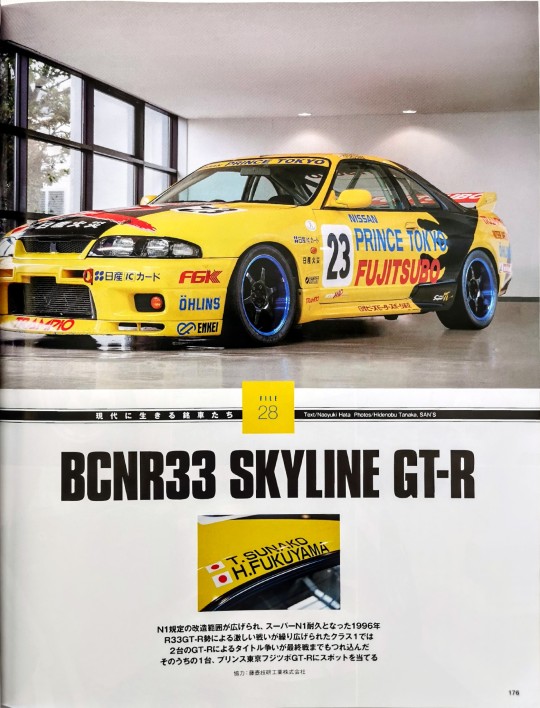
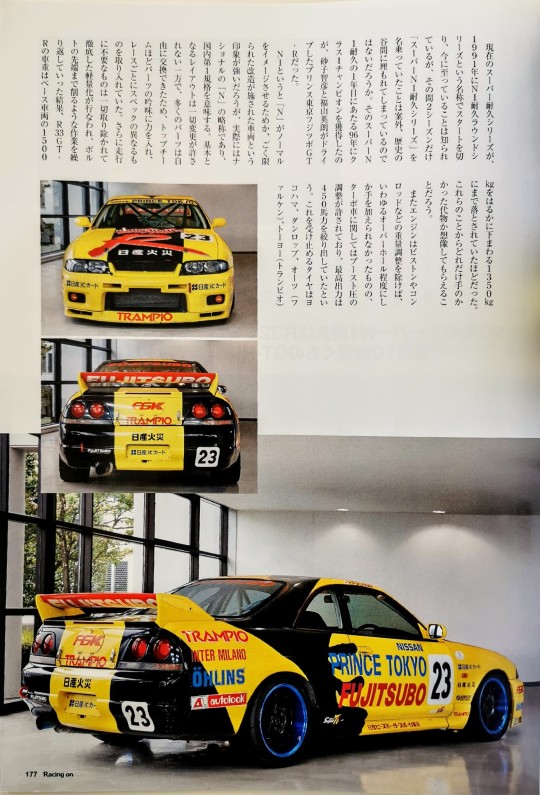
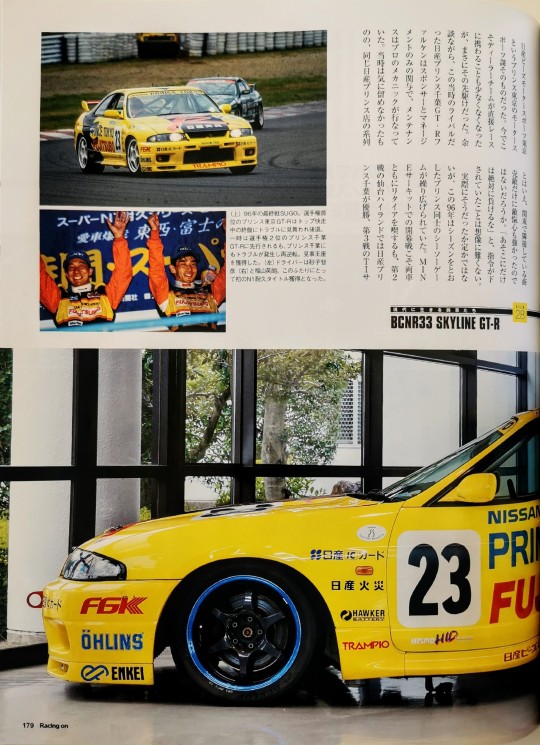
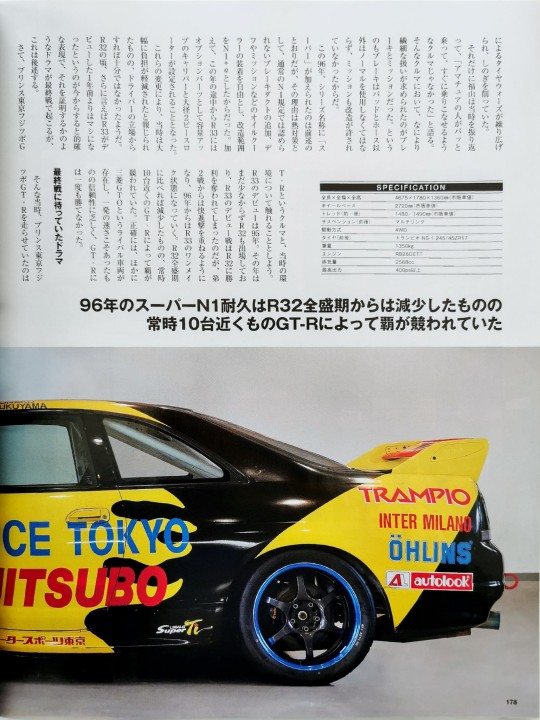
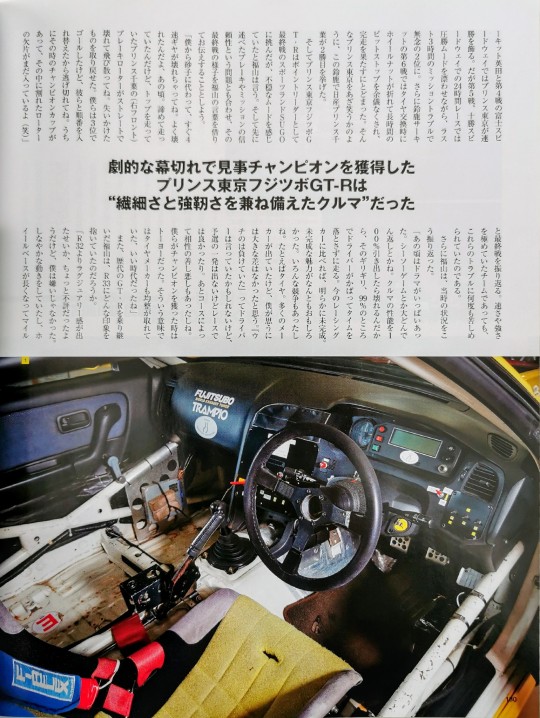
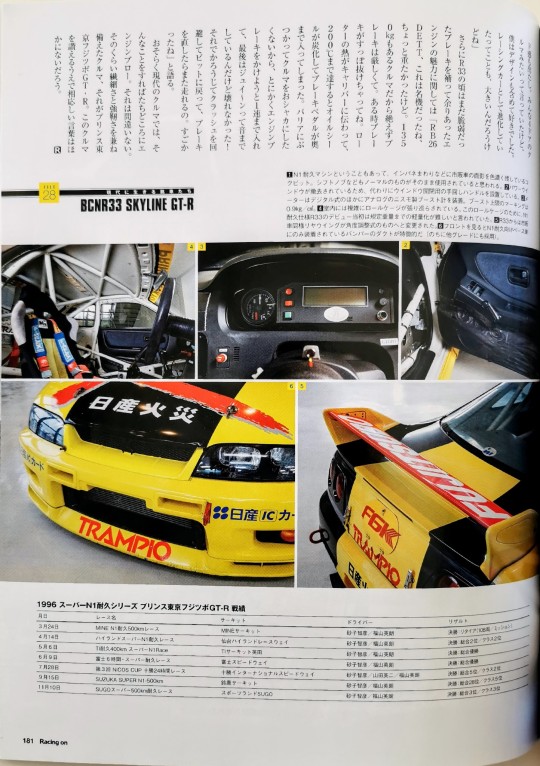
Translated Racing On magazine article on the Prince Tokyo Fujitsubo R33 Skyline GTR N1 racecar
Pics plus a translated article from a Racing On magazine on the Prince Tokyo Fujitsubo R33 Skyline GTR N1 racecar.
Translation below.
The range of modifications to the N1 regulations was expanded and the Super N1 became durable. 1996 R33 GT-R In class 1 where fierce battles were fought by the R forces, the title battle between two GT-Rs was entangled until the final race. Hit the spot on the platform, Prince Tokyo Fujitsubo GT-R.
It is known that the current Super Taikyu series started in 1991 under the name of N1 Endurance Round Series and has reached the present, but during that time it was called the "Super Taikyu Series" for only two seasons. Unexpectedly, it may have been buried in a valley of history. It was the first year of Super Taikyu's endurance, the 90th year, when the class champion was won by Tomohiko Ko and Hidenori Fukuyama. It was Prince Tokyo Fujitsubo GT-R. NI may have a strong impression that it is a vehicle with very limited modifications, probably because N is an image of normal, but it is actually an abbreviation for the national "N" and is the first in Japan. Means a standard. While the basic layout was completely unchangeable, many parts could be replaced on their own, so the top teams put more effort into scrutinizing the parts and incorporating different specs for each race. In addition, all unnecessary parts have been removed to reduce the weight thoroughly, and as a result of repeated work such as scraping to the tip of the bolt, the weight of the R33GT R is far more than 1500 of the base vehicle. It was about to drop to 13504, which is below. From these things, you can imagine how much the hand was. Also, except for the weight adjustment of the piston and connecting rod, the engine was not modified to the extent of so-called overhaul, but for turbo cars he is allowed to adjust the boost pressure, and the maximum output is squeezed out 450 horsepower. It is said that it was. The tires that catch this are Yokohama, Dunlop, and Oats (7 Toyo (Trampio).
The tire wars were unfolded and created a competitive edge. For that reason, Fukuyama looks back on those days and says, "He wasn't a car that an amateur could ride quickly and get on with." It was the brakes and he was the mission that required the most delicate treatment in the car. Because he had to use the brakes, he had to use the normal putt and outside the hose, and the mission was not allowed to be modified. As mentioned above, "Bar" was added to the series name this year, but the reason is that it is a heat countermeasure, and the addition of brake ducts, oil coolers such as differentials and missions, which are not permitted under normal regulations, are added. It was possible to install it freely, and the modification range was Nl + a. In addition, from the middle of this year, a capacity ab caliper and a large-diameter 2-piece rotor will be set as optional parts for the R unit. became . Although these changes were reported to have significantly reduced the burden at the time, it seems that he wasn't enough from the driver's point of view. Around the time of R, and for that matter, the fact that the R device was better than it was a year before its debut is now a more accurate expression, and a drama that seems to prove it will occur in the final battle. However, this will be described later. Now, let's talk about the Prince Tokyo Fujitsubo GT-R car and the boundaries at that time. R's debut was not a little in that year, and R33's debut match was deprived of R's victory, but from the second round, it started to make good progress, and from 1990. Is going into a one-make state of the R device. Although it decreased compared to the R heyday, the GT-R of nearly 10 cars was always competing for the fullness. To be precise, there was another rival vehicle called Mitsubishi GTO, which was unreliable despite the speed of one shot, and never beat the GT-R. The drama that was waiting for the final race At that time, the Brins Tokyo Fuji Acupoint GT-R was running because the Super N1 endurance in 1996 decreased from the R32 heyday, but it was always close to 10 GT-Rs. The championship was competing
It was affiliated with the same Nissan Prince store. I didn't care about it at the time, but it was done by a professional mechanic with only the involvement of the ment, and while the maintainer Alkene was reading the Nissan Prince Chiba GT R, which was sponsored and managed, the rival at that time was just the forerunner. The dealer team, which was less often involved, was the direct raceports section itself. Now, this time Chiba won the championship, and the opening race at the TI Circuit in Round 3 was the year-old Sendai Highland, where both Nissan and Nissan retired, but the second race was unfolding. Seesaw games between MIN Princes, but it's not hard to imagine that this year wasn't exactly the case throughout the season, but it's definitely not to lose. " I wonder if it wasn't there, because it was only ripe and strong, so I went to Prince Tokyo Motors Nissan Beads Motorsport Tokyo. In Kanto Prince Tokyo will grace the kit English and 4 year old Fuji Spi Hardway. Round 5 Tokachi Speedway 2 hour race with overwhelming mood, last 3 hours mission trouble In second place. Furthermore, in Round 6 of the Suzuka Circuit, the wheel nut broke when changing tires, and he was forced to make a pit stop for a long time. He gave his second win. And he said Prince Tokyo Fujitsubo GT-R, he challenged Sportsland SUGO in the final round as a point leader, but felt a disturbing mood. And as he mentioned earlier, he combined with the issue of braking and the reliability of his mission, and in Fukuyama's words he would tell him what the final race was like. "The gear broke immediately on behalf of Sunako from me. It broke often. At that time, I gave up and ran, but Prince Chiba, who was running at the top, right front) Brake rotor But it broke straight and splattered. I was able to get back what I was about to lose. We scored in the position, but we couldn't escape because we changed turns with them. We had the champion cup at that time. There are still broken rotor fragments in it (laughs). ”Looking back at the final race, even the team that was extremely fast and strong suffered from these troubles many times. Furthermore, Fukuyama looked back on the situation at that time. "At that time, there was a lot of drama. See-saw games and people turning around. If you pull out the performance of the car by 1 100% and it breaks, the driver will run at the last minute without losing time. Obviously unfinished and unfinished charm was really interesting compared to racing cars. There was a lot of competition. For example, tires. There were many makers, but I didn't think there was a big difference. I think. I was defeated. ”The driver may have said, but there was no one in the qualifying, but it was good in the race. Also, depending on the course, it was a good match. He was Toyo when we won his championship. In that sense, it was a good time for the tire makers to be well-proportioned. " "He was a little unpopular, probably because he was more luxurious than R, but I didn't dislike it, he was doing lithe movements, and the all-base became longer.
I don't know. The appropriate word to praise the car is the Barnacle GT-R, which is equipped with this car, which is Prince Higashi, which is as delicate and tough as it is. In that car, that's right. ”. After fixing it, I was able to avoid running again and returned to the bit, and the brakes barely turned the crash, but it didn't break! I couldn't get to the speed when I tried to rake up to the sound, so I just used the engine brake and put the car in the car. When the brake pedal reaches a depth of 200 ° C due to carbonization of the barrier, the heat of the oil seater is transferred to the caliber and the key is completely removed. The low rake was tough, and at one point it was a car with a break of 0 kg, so it was always a little heavy. 135 DETT This was a great machine, and when it comes to the appeal of the engine, "it was more than enough to supplement the RB250 brake, and it was still vulnerable around the time of the R33." The door of the ward that I liked, including the design
32 notes
·
View notes
Photo

New Post has been published on https://www.vividracing.com/blog/upgrade-your-wheels-new-vr-forged-designs/
Upgrade Your Wheels: New VR Forged Designs!
When you dive into the world of car modifications, the first upgrade on your list should definitely be a set of aftermarket wheels. There’s just no comparison between those factory wheels and the stunning, high-performance options available today. If you want your ride to look as good as it performs, you need quality wheels—and quality rhymes with VR Forged!
Why Forged Wheels?
Before we unveil our latest VR Forged designs, let’s talk about why investing in forged wheels is essential. When shopping for wheels, you’ll encounter three main manufacturing processes: cast, flow-forged, and forged.
Cast Wheels: While these are often the most affordable, cast wheels are heavier and generally weaker, making them less ideal for performance vehicles.
Flow-Forged Wheels: These are a step up, combining both casting and forging techniques. Although they offer better performance than cast wheels, they still can’t match the strength and weight savings of forged options.
Forged Wheels: This is where the magic happens! Forged wheels are crafted from a solid block of aluminum that undergoes a 10,000-ton press to compact the metal, resulting in an extremely lightweight and incredibly strong wheel. The benefits are clear: lighter wheels lead to improved handling and performance, making forged wheels a no-brainer for serious car enthusiasts.
youtube
Introducing Our Latest Designs
Now that we’ve established why you need forged wheels, let’s take a closer look at some exciting new designs from the VR Forged lineup!
1. VR Forged DZ-RE
First up is the VR Forged DZ-RE, designed specifically for the 2023+ RZ34 Nissan Z. This full 1-piece forged monoblock wheel features a sleek, multi-spoke construction that draws inspiration from old school motorsports design.
Specs: 19×9.5 +15mm front (27.2 lbs) and 19×10.5 +12mm rear (29.1 lbs)
Features: An integrated aero element helps provide weight savings and enhances performance.
The VR Forged DZ-RE is a full 1pc forged Monoblock wheel. The design of this wheel takes queues from true motorsports vehicles and current trends to showcase one of the sleekest wheel designs ever. The multi-spoke construction helps provide weight savings while the integrated ring provides and aero element. Manufactured using a 10,000 ton press, these wheels are incredibly strong.
The complete set for the Nissan Z comes in a staggered setup. 19×9.5 +15mm at just 27.2lbs on the front and 19×10.5 +12mm at 29.1lbs on rear.
2. VR Forged D16
Next, we have the VR Forged D16, available in satin bronze and gloss black. This wheel is perfect for off-road enthusiasts and is specifically designed for the Can-Am Maverick R.
Specs: Full 1-piece forged monoblock with a 6×139.7 bolt pattern.
Features: A simplistic split 6-spoke face for lightweight strength, complete with a functional bead lock ring and knurled bead for enhanced grip.
The VR Forged D16 Bead lock UTV wheel is a full 1pc forged Monoblock wheel designed for the serious off-roader. The design of this wheel is to be extremely strong and lightweight with its simplistic split 6 spoke face. In addition to the functional bead lock ring, we also provide a knurled bead for additional grip when running lower pressures.
This wheel was designed specifically for the Can-Am Maverick R with a 6×139.7 bolt pattern.
3. VR Forged DX1
Last but not least, the VR Forged DX1 is tailored for European, exotic, and tuner vehicles, drawing inspiration from the Porsche 992 GT3RS.
Specs: Porsche 922 GT3 Fitment: 21×12 +45mm (29 lbs) rear and 20×9.5 +45mm (24.9 lbs)
Features: Lightweight spoke design with a hex pattern and a center lock wheel hub for that sleek, high-performance aesthetic.
This wheel is inspired from the latest Porsche 992 GT3RS supercar. Featuring a lightweight spoke design with a hex pattern towards the center. This wheel is a great reinterpretation to the traditional mesh motorsports wheel design.
And yes that is a center lock wheel hub! As this specific wheel is indeed for a Porsche 992 GT3 Center lock car.
To make things even better, this 21×12 +45mm monster comes in at a spry 29 pounds! The fronts that are included in the 992 GT3 set are a 20×9.5 +45mm that clock in at just 24.9lbs!
Custom Solutions
We pride ourselves on offering a wide range of options to fit various vehicles. If you have specific sizing needs, don’t hesitate to reach out to our performance specialists. They are here to help you find the perfect fit for your build!
Upgrading to aftermarket wheels is one of the best ways to enhance your vehicle’s performance and style. With VR Forged wheels, you’re not just getting a product; you’re investing in quality and craftsmanship that will elevate your driving experience. So, why settle for factory wheels? Go forged and feel the difference!
0 notes
Photo

2017 Yamaha Bolt R-Spec
https://www.facebook.com/MototcyclesAndMore/
38 notes
·
View notes
